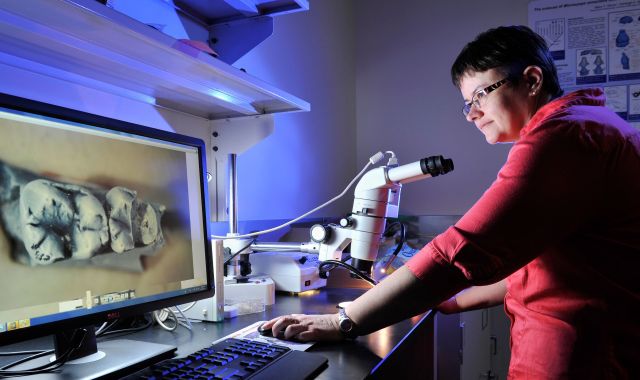
This week’s Royal Tyrrell Museum Speaker Series hosts two sessions. The first presentation, held on Thursday, February 11, will feature Calla Carbone, Royal Tyrrell Museum Technician, who will present “The Ediacaran Period – Glimpses of the Earth’s Earliest Animals.” The second presentation, held on Friday, February 12, will feature Dr. Mary Silcox of the University of Toronto who explores “Why So Big? Understanding the Early Evolution of the Brain in Primates and Their Relatives Using the Fossil Record.”
The Ediacaran Period of Earth’s history lasted from 635 to 541 million years ago and represents an important and exciting step in the evolution of life on Earth. The Ediacaran is of great interest to scientists because it is the period during which life transitioned from microscopic single cells, too small to see with the naked eye, into large and complex multicellular organisms, similar to those that inhabit much of the world today. The Ediacaran period was only officially accepted in 2004 and as such there are many big questions that are still being debated, such as what these organisms are most closely related to, and why they disappeared. In her talk, Carbone explores the new discoveries constantly being made, which allow us to piece together the morphologies and behaviours of these enigmatic creatures, and ultimately the earliest evolution of animals.
Dr. Silcox’s main research focus is on the earliest evolution of our own Order, the Primates. In particular, she studies fossils of some of the most primitive primates, which date to the period just after the extinction of the dinosaurs, some 65 million years ago. Her talk on February 12 will focus on one particular characteristic of primates that has garnered a lot of attention: large brain size. Humans are exceptional as mammals with the largest brains relative to our body size, and the members of our Order are also typically quite “brainy” compared to other groups. Although there has been a lot of research on living primates to try and understand the evolution of this feature, much less work has been done probing the fossil record for what it can tell us about the early evolution of the brain.
The Royal Tyrrell Museum’s Speaker Series talks are free and open to the public. For more information, visit tyrrellmuseum.com.





















